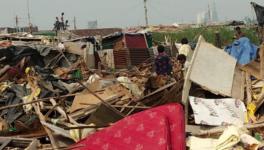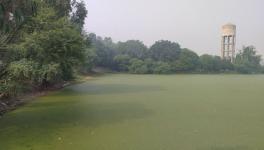Yellow Smog Blankets Delhi, Air Quality Worse Than Day After Diwali

Image Courtesy: BBC.com
The National Capital Region on Tuesday saw its worst 'air quality' and 'smog situation' of the year -- which was even worse than a day after Diwali, as a yellow blanket of smog hung heavily in the sky. The pollution level rose to dangerous levels, with 18 out of 21 active pollution monitoring stations recording 'severe' air quality.
According to data from the Central Pollution Control Board (CPCB), the average Air Quality Index (AQI) of Delhi at 3 p.m. was 446 -- with major pollutant PM2.5, or particles with a diameter less than 2.5mm recorded at 418 units. This is worse than a day-after Diwali -- October 20, 2017, when the AQI was recorded at 403, while the effluents on Tuesday were just a few notches below the index value recorded a day after Diwali-2016 (October 31) which was 443.
The average AQI in Delhi-NCR combined was recorded 412 -- considered 'severe', while PM2.5 volume was 400 units as reported by CPCB at 1 p.m.
At different locations of Delhi-NCR, the PM2.5 value was found to be 23 to 19 times higher than the permissible limit.
The safe limit for PM2.5 is 60 micrograms per cubic meters according to the national standards, and 25 micrograms per cubic meters as per the international standards.
According to weather analysts, Delhi is suffering from one of its worst "smog situations". The negligible wind speed along with other meteorological reasons are behind the spike in air pollution, along with unabated stubble burning in neighbouring Punjab and Haryana.
"Currently the westerly winds from Rajasthan and Haryana are flowing at negligible speed, this causes the condensation of air near the surface which thereby mixes with the pollutants from local emissions and those from the stubble burning. This is the reason that there is no scope of dispersal of the pollutants for now," Mahesh Palawat, Director private weather forecasting agency, Skymet told IANS.
"The situation will remain same for next few days," Palawat added.
Recording severe PM2.5 levels at all its 10 monitoring stations across Delhi-NCR, the central government's 'System of Air Quality and Weather Forecasting And Research (SAFAR)' has cautioned 'everyone' in the region to "avoid walks, outdoor activities, burning anything including incense sticks and candles, shut the windows, mop the floors and not vacuum clean and use only N-95 or P-100 standard respirators and not to rely on dust masks".
According to SAFAR's data, that predicts the air quality of Delhi-NCR to remain 'severe' for the next two days as well, the PM2.5 ranged from 453 unit (minimum) at Pusa to 569 (maximum) at Lodhi road at 2 p.m.
The Delhi Pollution Control Committee (DPCC) recorded a PM2.5 of 558 units at 2 p.m. in Anand Vihar, with CPCB measuring the AQI at 439.
Analyzing the severity of air quality based on AQI -- that combines PM2.5 (major cause of air-pollution in Delhi-NCR) and PM10, and other effluents, Burari Crossing in North Delhi has the cleanest air with a 378 AQI, followed by 361 at Vikas Sadan in Haryana's Gurugram and 350 at Rohtak (Haryana) -- all considered 'very poor' while all other regions in Delhi-NCR had 'severe' AQIs with dangerous trend in PM2.5 levels.
The AQI levels recorded were -- Delhi Technical University (452), Punjabi Bagh (435), Dilshad Garden (413), North Campus (445), Shadipur (466), Mandir Marg (433), Pusa (453- SAFAR data), Dwarka (435), Lodhi Road (569-SAFAR data), R.K. Puram (437), Siri Fort (430), Mathura Road (464), Aya Nagar (409), Anand Vihar (439), Faridabad (412), Sector-125 Noida in Uttar Pradesh (449), Sector-62 Noida (443) and Vasundhara in Ghaziabad (443).
Get the latest reports & analysis with people's perspective on Protests, movements & deep analytical videos, discussions of the current affairs in your Telegram app. Subscribe to NewsClick's Telegram channel & get Real-Time updates on stories, as they get published on our website.
























